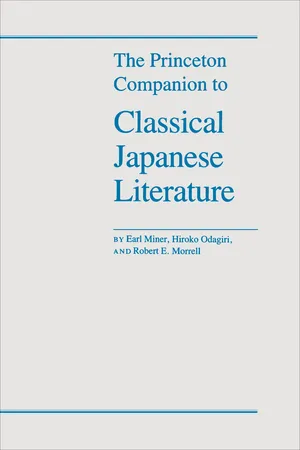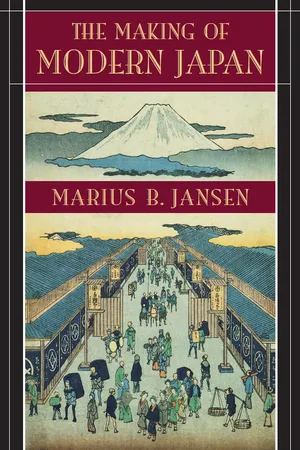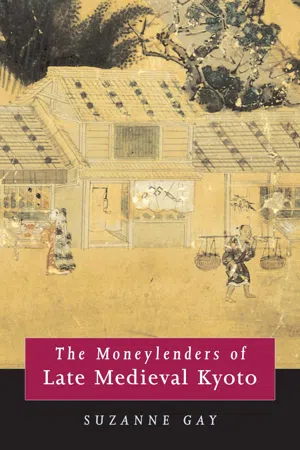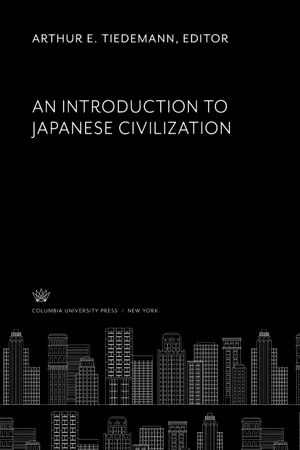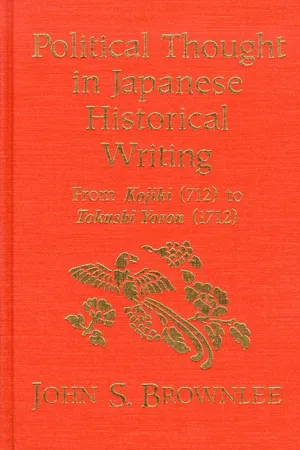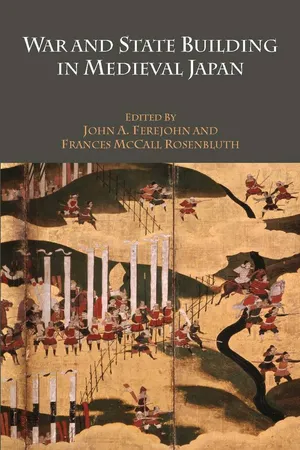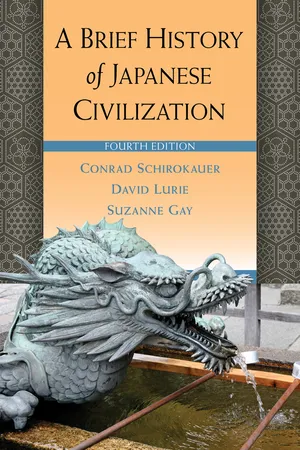History
Ashikaga Shogunate
The Ashikaga Shogunate was a feudal military government in Japan established by the Ashikaga clan in the late 12th century. It marked a period of decentralized rule and cultural flourishing, known as the Muromachi period, characterized by the influence of Zen Buddhism and the development of the tea ceremony and Noh theater. The shogunate faced internal strife and external threats, ultimately leading to its decline in the 16th century.
Written by Perlego with AI-assistance
Related key terms
1 of 5
12 Key excerpts on "Ashikaga Shogunate"
- eBook - ePub
- Jeremy Black(Author)
- 2005(Publication Date)
- Routledge(Publisher)
Chapter ThreeWarfare in Japan 1467–1600Paul VarleyJapan in the mid-fifteenth century was a country on the verge of disintegration. Its emperor, whose court was located in Kyoto, had not exercised real authority for centuries, but was a “sacred legitimizer” of the rule of others. From the late twelfth century, when the first warrior—samurai—government was established at Kamakura in the Kant or eastern provinces (a government known in English as “shogunate”, because its head was the shogun or “generalissimo”), the effective rulers of the land were warrior chiefs. The Kamakura Shogunate spanned the years 1185–1333, and was replaced, after a brief hiatus, by the Ashikaga Shogunate, 1336–1573, which was situated in Kyoto in proximity to the emperor and his court and headed by shoguns of the Ashikaga family.The Ashikaga Shogunate came into existence in 1336 at the commencement of a sanguinary conflict, known as the War Between the Courts, that was not settled until 1392. Even after this war the Shogunate was able to exercise only limited control of the country. Its leader, the shogun, presided as hegemon over semi-independent warrior chiefs invested by him as constables (shugo) of the various provinces (66 in all) into which Japan was divided. But distant areas of the country, especially the island of Kyushu in the west and the northern reaches of the main island of Honshu, were largely beyond effective Shogunate administration, and in the early fifteenth century the vital Kant region, heartland of the warrior class, also slipped from Shogunate control and lapsed into disunion. During the nin War, 1467–77, the Ashikaga Shogunate was reduced to nearimpotence, and Japan itself was plunged into the age of Sengoku or “The Country at War”, 1467–1568.1 - Earl Miner, Robert E. Morrell, Hiroko Odagiri, Earl Roy Miner(Authors)
- 2020(Publication Date)
- Princeton University Press(Publisher)
One of the more enterprising, Yoshimochi (fourth shogun), affected the title of sovereign in dealing with the Chinese court. Whatever the boast of one shogun or the youth of another, in Japanese fashion the institution could prove stronger than any individual occupant when buttressed by powerful—and loyal—shugo. Such happy circumstances were always a matter of lucky balance, and the Ashikagas can be judged variously as spendthrifts or as brilliant patrons of the arts, as power-seekers or as people who did the best anyone might have done in an increasingly impossible situation. F. ANARCHY, POTENTATES; FROM THE AZUCHI-MOMOYAMA PERIOD TO THE EDO BAKUFU Although the Muromachi bakufu continued to have its shoguns till 1573, its last incumbent was really a figurehead. How this came about requires attention to the civil wars that had been ravaging the country. Among these, one was the Onin War (1467-1477), which devastated the capital and made it largely un-inhabitable during much of the decade or so of fighting. But the period from 1482 to 1568 was a time of such constant and bloody tumult throughout the land that it (or all of 1467-1568) goes under the name of the Sengoku jidai ScH B#ft, that is, the era of the nation or the provinces at war. Japan was clearly ready either for prostration or for rule by some strong figure capable of government. The Azuchi-Momoyama period brought strength and government in three stages represented by potentates of quite differing disposition. The first was Oda Nobunaga $& H fit ft (1534-1582). From his base of power in Owari and Mikawa (the modern Nagoya region), he gradually moved westward. By 1568, he was acting on behalf of the last Muromachi shogun, Ashikaga Yoshiaki, entering Kyoto nominally to exert bakufu authority. Before long, he had made Yoshiaki a puppet and was de facto ruler of much of the country, at least of central Japan.- eBook - PDF
- Marius B. Jansen, Marius B. Jansen(Authors)
- 2009(Publication Date)
- Belknap Press(Publisher)
By 1333 a discontented emperor was 4 The Making of Modern Japan able to rally enough discontented warriors to bring the Kamakura shogunate to its final crisis. The second shogunal line, that of the Ashikaga, chose to establish its head-quarters in the imperial capital of Kyoto. The title of shogun was now formally linked with the designation of leader of the military houses (buke no to ¯ryo ¯), but in fact he experienced increasing difficulty asserting his primacy over the provincial warrior administrators. The discontent the emperor had exploited to bring on the crisis of 1333 extended throughout that century. At a time when rival papacies at Avignon and Rome vied for authority in the West, competing military houses in Japan maintained rival imperial lines. Three-quarters of a century of warfare were brought to an end only by a compromise under which the two lines alternated in office. Meanwhile the power of the imperial house continued to diminish. Although the Ashikaga shogun’s writ did not run far beyond the heartland of classical Japan, within it his preten-sions grew until the shogun Ashikaga Yoshimitsu styled himself “King of Ja-pan” when he engaged in foreign policy with the Ming emperors of China. Yoshimitsu ( 1358–1408 ) was passionately eager to show himself a cultured aesthete capable of dealing with continental culture, and he was assiduous in collecting evidence of that cultivation in the form of paintings and ceramics. He had hundreds, perhaps thousands, of contemporaries who were no less eager, and much less restrained, in taking what they wanted. The fourteenth and fifteenth centuries were conspicuous for the appearance of piracy that preyed on the settled civilizations of Korea and China. The wako ¯, as the raiders were called, were based for the most part on islands off the coast of the Japa-nese island of Kyushu. - eBook - PDF
Japan
History and Culture from Classical to Cool
- Nancy K. Stalker(Author)
- 2018(Publication Date)
- University of California Press(Publisher)
In contrast to the Kamakura bakufu, which coexisted with the court in a bal-ance of power between the warriors in the eastern part of the country and the courtiers in the west, the Ashikaga took over court privileges in Kyoto. The capital was thronged with soldiers, and the military elites immersed themselves in the culture of the court, aspiring to emulate its elegance, while treating the courtiers themselves with contempt. The Ashikaga shoguns thus lived in luxury, supporting the arts and the intricacies of court hierar-chy rather than concentrating on affairs of state. Kamakura shoguns had been satisfied with modest court ranks, but the Ashikaga took the highest offices of court and lived in keeping with this position. When Yoshimitsu abdicated in 1395 , he retired to his luxurious villa, known today as the Golden Pavilion (Kinkakuji), where he continued to rule behind the scenes, just like the cloistered emperors of earlier years. After the fall of the Mongol dynasty, Yoshimitsu reestablished regular embassies to China’s new rulers, the Ming. China once again became a model for cultural emulation, as well as a source of Ashikaga income from controlling trade with the Ming. The bakufu built many new seaports to support China-related trade and commerce. Nevertheless, the Ashikaga grip on national power was never as firm as that of their Kamakura predeces-sors, because they possessed neither extensive landholdings nor their own significant military power. They had to rely instead on the cooperation and loyalty of the shugo constables they appointed to govern the provinces. Many of these shugo began to exercise power autonomously within their landholdings. - eBook - PDF
- Suzanne Gay(Author)
- 2001(Publication Date)
- University of Hawaii Press(Publisher)
The medieval emperor, even as a small figure retreating into a series of palaces and borrowed residences, possessed an aura of sanctity and authority; he was not replaceable by any other entity in the political order. Aristocrats supported the emperor as court officials, even as the real power of the civil government atrophied. They also held landed estates in a private capacity, and some brokered lucrative overlord arrange-ments with commercial groups. The glory days of the Heian period may have been long over, but aristocratic wealth and privilege proved quite durable. Ashikaga Takauji founded the Muromachi shogunate in 1336. Relative latecomers to Kyoto, the Ashikaga warriors fundamentally changed the power balance in the city by establishing their headquarters there. Unlike the Kamakura shogunate, which had maintained only a limited presence in Kyoto, for a time the Muromachi shogunate made Kyoto the very base of the warriors, who were primarily a provincial phenomenon. Despite their military capabilities, however, they were not able to have their way in Kyoto completely. In the medieval balance of multiple elites, both the aristocracy and the religious establishment continued to be forces to con-tend with. Nevertheless, the warrior impact on Kyoto was soon evident. The Ashikaga and their supporters were not merely the latest rulers to arrive in the city. The important functional difference between them and the other elites was based in part on their military capacity: city adminis-tration, including adjudication and the enforcement of law and order, often involved the use of force, or at least the threat of force. Their application of existing warrior legal conventions to a broader social spectrum was also a significant factor in their ability to administer the city. - eBook - PDF
Kyoto
An Urban History of Japan's Premodern Capital
- Matthew Stavros, Ronald G. Knapp, Xing Ruan(Authors)
- 2014(Publication Date)
- University of Hawaii Press(Publisher)
The shogun, it seems, remained reticent about violating the foun-dational taboo barring warriors and temples from the city. He even went so far as to defer to the court on questions of capital land distri-bution. The findings of this first section force a re-evaluation of the extent of Ashikaga assertiveness in medieval Kyoto, even at the zenith of the regime’s power. The standard narrative depicts the shogunate as a growing and eventually ineluctable force of political, economic, and physical change, one that ruled by fiat and according to supposedly unique “warrior” sensibilities. We discover here, however, evidence of a marked reluctance to violate age-old customs and a powerfully conservative impulse vis-à-vis capital spatial norms. This stance, it is argued, helped the Ashikaga gain legitimacy by enabling them to play the part of dutiful servants of the state. The impulse to become fully endowed members of the state bureaucracy helps explain the findings of the second section, which show that successive Ashikaga leaders consistently built residential headquarters in the shinden style. Doing so endowed them with the architectural infrastructure necessary to conduct rituals of state that helped authenticate their membership in the imperial hierarchy. The findings reinforce the suggestion that the Ashikaga sought to Warriors in the Capital 105 influence traditional spheres of influence through infiltration rather than coercion. This section also calls into question a widely accepted impression that the Ashikaga shoguns were pioneers of shoin -style architecture, the precursor of traditional Japanese residential architecture. As we shall see, to the extent that the Ashikaga shoguns built structures in that emerging style at all, they were more likely responding to pre-existing trends instead of forging new ones. The same section concludes with a brief reflection on yet another way warriors used architecture to “build” legitimacy in medieval Kyoto. - eBook - PDF
- (Author)
- 2019(Publication Date)
- Columbia University Press(Publisher)
The northern (senior line) court meanwhile became simply a fa?ade for the Ashikaga Shogunate, whose headquarters Takauji established in Kyoto. Regionalism became an increasingly important factor during the opening years of the Ashikaga Shogunate. In contrast to the earlier Minamoto and Höjö, the Ashikaga were able to achieve a hegemony little better than that of primus inter pares. The need to bring at least partial order when warfare between the courts seemed un-ending forced them constantly to make concessions in the form of rewards in land and greater administrative authority to newly ap-pointed constables and allied commanders who were themselves striv-ing to establish control in the provinces. It was not until the period of the third Ashikaga shogun, Yoshimitsu, whose rule commenced in 1368, that some semblance of a cohesive system of central and regional military government reemerged. Constable authority during the Kamakura period had been limited to certain police powers and to responsibilities related to the muster-ing of shogunal housemen for guard duty. During the early Muro-machi period (so named because from Yoshimitsu's time the sho-gunate's offices were located in the Muromachi section of northeast Kyoto) the constables, or constable-daimyö 1 as they are designated by modern scholars, became virtually autonomous rulers of one or more provinces. The Yamana family at one point held as many as eleven. To maintain command of their regional domains, however, 1. The term daimyö means, literally, great name. From about this time on it increasingly came to be used to signify regional magnates. THE AGE OF THE MILITARY HOUSES 7 7 the constable-daimyö were obliged to rely to some extent upon the support of the shogunate and upon cooperation with each other. Under Yoshimitsu a balance of power between shogunate and con-stable-daimyö was evolved which proved workable for nearly a century. - eBook - ePub
Japanese Family and Society
Words from Tongo Takebe, A Meiji Era Sociologist
- Phil Barker, Teruhito Sako, Suzanne K Steinmetz(Authors)
- 2007(Publication Date)
- Routledge(Publisher)
This action resulted in the loss of the support of the daimyōs who had been instrumental in the emperor regaining the throne. Unable to retain control without the support of the daimyō, Go-Daigo fled to Yoshino in the south of Kyoto and established the Southern court (Japan-Guide, 2005). The two imperial courts, the Northern (Kyoto) and Southern court (Yoshino) existed for over fifty years until 1392 when the Northern Ashikaga court became the dominant single court. The Ashikaga clan held power for 200 years, but during the fifteenth and sixteenth centuries, the Ashikaga Shogunate and the government at Kyoto declined considerably. At the same time, the daimyō, who were not loyal to the central authority but to the local warrior followers, gained in power. Their power was further increased during the ten-year Ōnin War (1467–1477) followed by a century of warfare (Sengoku Jidai). 10 The Ashikaga Shogunate (and vassals they controlled), the daimyō (and lower-level samurai warriors and peasants loyal to them), and court-appointed civil governors competed for financial and political power. The influence of the Ashikaga bakufu [shogunate] in Kyoto drastically declined and the shōen system was severely damaged. The centralized Confucian-based government was replaced by the daimyō who expanded their landholdings, which varied in size from small castle towns to areas the size of former provinces. They assembled feudal armies consisting of peasants and levied taxes directly on the peasantry. However, they were able to maintain the loyalty and support of the peasants, because they also instituted improvements by promoting local economic development, building roads, reclaiming lands, and developing irrigation systems and other public works (Schirokauer, 1993). Although the imperial court and shoguns had experienced a decline in power, their energy was redirected toward developing art and refined culture - eBook - PDF
Political Thought in Japanese Historical Writing
From Kojiki (712) to Tokushi Yoron (1712)
- John S. Brownlee(Author)
- 2006(Publication Date)
- Wilfrid Laurier University Press(Publisher)
Yet the Tokugawa Bakufu itself did not formally establish any theory that advanced beyond the traditional idea of the preceding Kamakura and Ashikaga Bakufu, that the Emperor had delegated his military authority to the Shogun. The Bakufu continued with the cere-monies that embodied this notion. Yet it was clear in early Tokugawa Japan that such a limited theory failed to encompass the new reality of a powerful government claiming complete jurisdiction over every inch of Japanese territory, even though its rule over the feudal domains was indirect. Numerous scholars and officials undertook studies that were related to the problem of legitimacy of the Bakufu, with the bulk of them turning to Confucianism, which thrived from the early seventeenth century throughout the period. It is not surprising that the Tokugawa Bakufu encouraged such studies. 1 Within this general context of schol-arly activity related to legitimacy, Arai Hakuseki was the last major figure to continue in the previous tradition of expressing political ideas through historical writing. Events had run far ahead of the concerns of traditional historical writing. It must have been evident to Hakuseki, as it was not to Kitabatake, that the actions of men from the fourteenth century onward had nothing to do with the imperial house or the imperial state. The imperial regalia were forgotten in the maelstrom of medieval warfare, and the imperial state ceased completely to exist, although there was always a court, however impoverished. The Emperors lived a meagre and fugitive existence, until finally pity was taken on them by Toyotomi Hideyoshi and Tokugawa leyasu, who restored them at least to reason-able living conditions. Thus Arai Hakuseki was unencumbered by the SECULAR, PRAGMATIC HISTORY IN TOKUSHI YORON (1712) 119 idea that the Emperors ought to be a factor in the development of history. - eBook - ePub
- John A. Ferejohn, Frances McCall Rosenbluth(Authors)
- 2010(Publication Date)
- Stanford University Press(Publisher)
menka ). Furthermore, households had workshops for food, clothes, and agricultural tools, and were highly self-sufficient. In the unit of the household, kin members and retainers controlled tenant workers and protected landed estates. Local social order was maintained through the coexistence of these large operating units, which also placed neighboring peasants under their control and protection.A master controlled his household, and even the government could not easily intervene in its internal affairs. For example, Article 26 of the Goseibaishikimoku (Jōei Formulary) enacted by the Kamakura shogunate recognized a master’s right to his land (honryo ) and his right to pass it along to his children. A parent’s intention was given priority over that of the shogun.In 1333, the Hojo family lost its grip on the Kamakura shogunate, in part because expensive preparations against Mongolian invasions had consumed enormous resources. Central tax revenues were minimal, forcing the shogunate to rely on the loyalty and support of its vassals, but the Hojo had no more lands with which to reward the local lords for their expenditures and work. With the shogunate in this weakened state, Emperor Go Daigo declared war on the shogunate, and his general, Nitta Yoshisada, raised an army that destroyed the Kamakura forces. In spectacular battles fought over the next few years, the emperor’s and clan armies vied for hegemony. Both sides were so weakened by the effort that in the end Ashikaga Takauji, a former Kamakura vassal, emerged from the shadows and established a new shogunate under his own name.8The Ashikaga government gave local jurisdiction to military generals (shugo ), who became daimyō or domain lords. These local lords were given authority to punish illegal activities such as harvesting someone else’s rice plants (karida-rozeki ). The government also established a law called kosenbosen-ho to restrict private wars. The term kosen means initiating a fight, while the term bosen means protecting oneself against it by force. In the beginning, only the aggressors were punished. In time, the daimyō agreed to the kenka-ryōseibai-hō - eBook - PDF
Above the Clouds
Status Culture of the Modern Japanese Nobility
- Takie Sugiyama Lebra(Author)
- 1993(Publication Date)
- University of California Press(Publisher)
After the short interval of Nobunaga and Hideyoshi, the Tokugawa reestablished an elaborate system of dyarchy in which the symbol of authority and its administration ruled jointly. The Tokugawa, while ruth-lessly depriving the emperor and his court of political and economic autonomy, adhered to the precedent established by Yoritomo of having the emperor authorize the appointment of each new shogun (shogun senge). The shogun, in turn, was elevated (?) to the position of a symbol who did not govern; and the same pattern was repeated by each daimyo, who held symbolic hegemony over his han (feudal domain) and left its governance to his administrator-vassals. Nevertheless, the symbol was not empty: The daimyo might not actually govern, but the men who did govern did not try to displace him or undercut his prestige (Strayer 1968, 10). The same was true of the relationship between the shogun and daimyo: the daimyo was lord and master of his domain, yet he accepted the shogun's authority to alienate him from the domain by transferring him (kunigae), even confiscating his territory, and forcing him to reside every other year or so in Edo, the shogunal capital. The daimyo, in short, was what Strayer (1968, 9) calls an autonomous but obedient prince. It seems that the equilibrium of 42 Creating the Modern Nobility asymmetric dyarchy at various levels of the total hierarchy was maximized under Tokugawa feudalism, which may explain the survival of the Toku-gawa shogunate for 260 years. The dyarchy did not come to an end with the Meiji Restoration, but was re-formed by the imperial sovereign and a group of upstart leaders of samurai origin who were to become part of the modern nobility. The dyarchical order went out of control in the 1930s and into the war period, when military officers resorted to violent attacks on the civilian arm of the dyarchy. To return to the medieval era, we find the weight of history also felt in the aristocratic life-style. - eBook - PDF
- Conrad Schirokauer, David Lurie, Suzanne Gay, , Conrad Schirokauer, David Lurie, Suzanne Gay(Authors)
- 2012(Publication Date)
- Cengage Learning EMEA(Publisher)
His improvements included administrative rationalization, settlement of conflict-ing land claims, and a strengthening of the shogunate’s finances. Spending was reduced, and new sources of revenue were opened by taxing the wealth of com-mercial enterprises such as sake breweries and moneylenders. (These two occupa-tions were frequently pursued simultaneously because the original capital of the pawnshops often came from the profits of the sake trade.) Indeed, the Ashikaga Copyright 201 Cengage Learning. All Rights Reserved. May not be copied, scanned, or duplicated, in whole or in part. Due to electronic rights, some third party content may be suppressed from the eBook and/or eChapter(s). Editorial review has deemed that any suppressed content does not materially affect the overall learning experience. Cengage Learning reserves the right to remove additional content at any time if subsequent rights restrictions require it. Chapter 5 ■ Muromachi Japan 99 shogunate, unlike its predecessor, drew substantial revenues from commercial sources in the capital. When Yoshimitsu took power into his own hands, he continued efforts to strengthen the shogunate. He successfully met several military challenges, and in 1392 secured the reunification of the two imperial courts. A final campaign in 1399 achieved a workable balance of power in the country. Yoshimitsu used elaborate processionals to religious sites such as Mount Ko ¯ ya, Ise, and Iwashimizu to display his power, demonstrate piety, and inspect local conditions firsthand. His lavish patronage of religious establishments no doubt helped win him their support. Unlike the first two Ashikaga shoguns, Yoshimitsu was born and raised in Kyoto and sought to combine his warrior heritage with values long cherished there. In gratifying his taste for fine architecture and beautiful gardens, he spared no expense.
Index pages curate the most relevant extracts from our library of academic textbooks. They’ve been created using an in-house natural language model (NLM), each adding context and meaning to key research topics.

